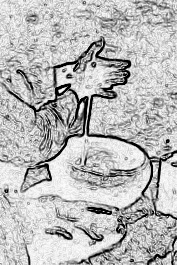Pottery-Making Techniques
The production of ceramic vessels requires detailed knowledge of the physical properties of different clays and tempering materials, as well as knowledge about how these combine and react under specific firing conditions. Potters knew where to find and identify quality clays sources and understood what materials to add to the clay to prevent it from cracking during drying. They recognized the limits of the tempered clay's strength during shaping and after firing. Potters also employed a range of techniques and methods in decorating their containers; some of these decorations transmitted important symbolic information as well. Without kilns, special skills were required in using open fires to produce pots. When ceramic-making arrived in Canada, it was adapted to take into account local needs and raw materials.
By studying the small fragments left behind at archaeological sites, archaeologists have identified two potter-manufacturing techniques.
The Coil Method
 The earliest technique found in southern Canada is referred to as the "coil method", which involves the preparation of long ropes of tempered clay. The artisan builds up the walls of the container by successively adding coils either spirally or as rings, smoothing over the joints and thinning the walls. The characteristic conoidal shape of these early vessels (for example, pots 10 and 13) may be the result of artisans beginning with the vessel opening, then winding their way toward the base. This rising arch provided a stable form and permitted greater control of the pliable clay. Invariably though, a thick plug had to close the base, and these are standard to all pot bases of this early period.
The earliest technique found in southern Canada is referred to as the "coil method", which involves the preparation of long ropes of tempered clay. The artisan builds up the walls of the container by successively adding coils either spirally or as rings, smoothing over the joints and thinning the walls. The characteristic conoidal shape of these early vessels (for example, pots 10 and 13) may be the result of artisans beginning with the vessel opening, then winding their way toward the base. This rising arch provided a stable form and permitted greater control of the pliable clay. Invariably though, a thick plug had to close the base, and these are standard to all pot bases of this early period.
 Sometime in the middle of the first millenium A.D., a new method appeared, which was to continue until contact with Europeans. It is primarily a modeling technique in which the potter begins with an initial mass of tempered clay that is shaped and drawn upwards manually. Additional pieces might be added to complete the pot. The exterior surface was slapped with textured paddles, undoubtedly against anvils held on the inside of the pot in order to thin the walls and draw the clay upwards.
Sometime in the middle of the first millenium A.D., a new method appeared, which was to continue until contact with Europeans. It is primarily a modeling technique in which the potter begins with an initial mass of tempered clay that is shaped and drawn upwards manually. Additional pieces might be added to complete the pot. The exterior surface was slapped with textured paddles, undoubtedly against anvils held on the inside of the pot in order to thin the walls and draw the clay upwards.
Some researchers have suggested that the shaping of the containers, in many instances, may have taken place inside woven molds that left distinctive textile impressions. The initial pot would have been made using the coil method but later paddling would have obliterated evidence of these coils.
Back